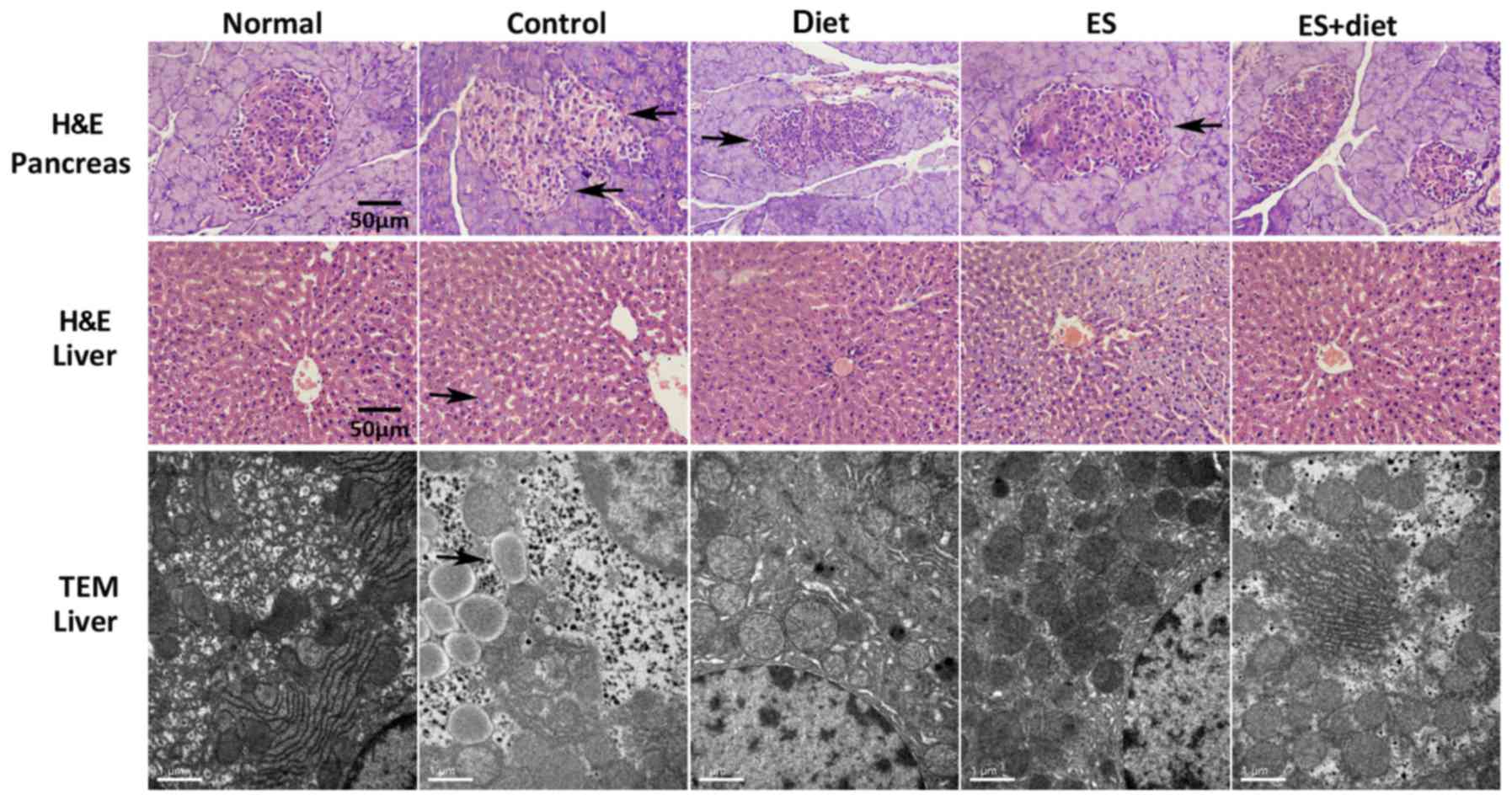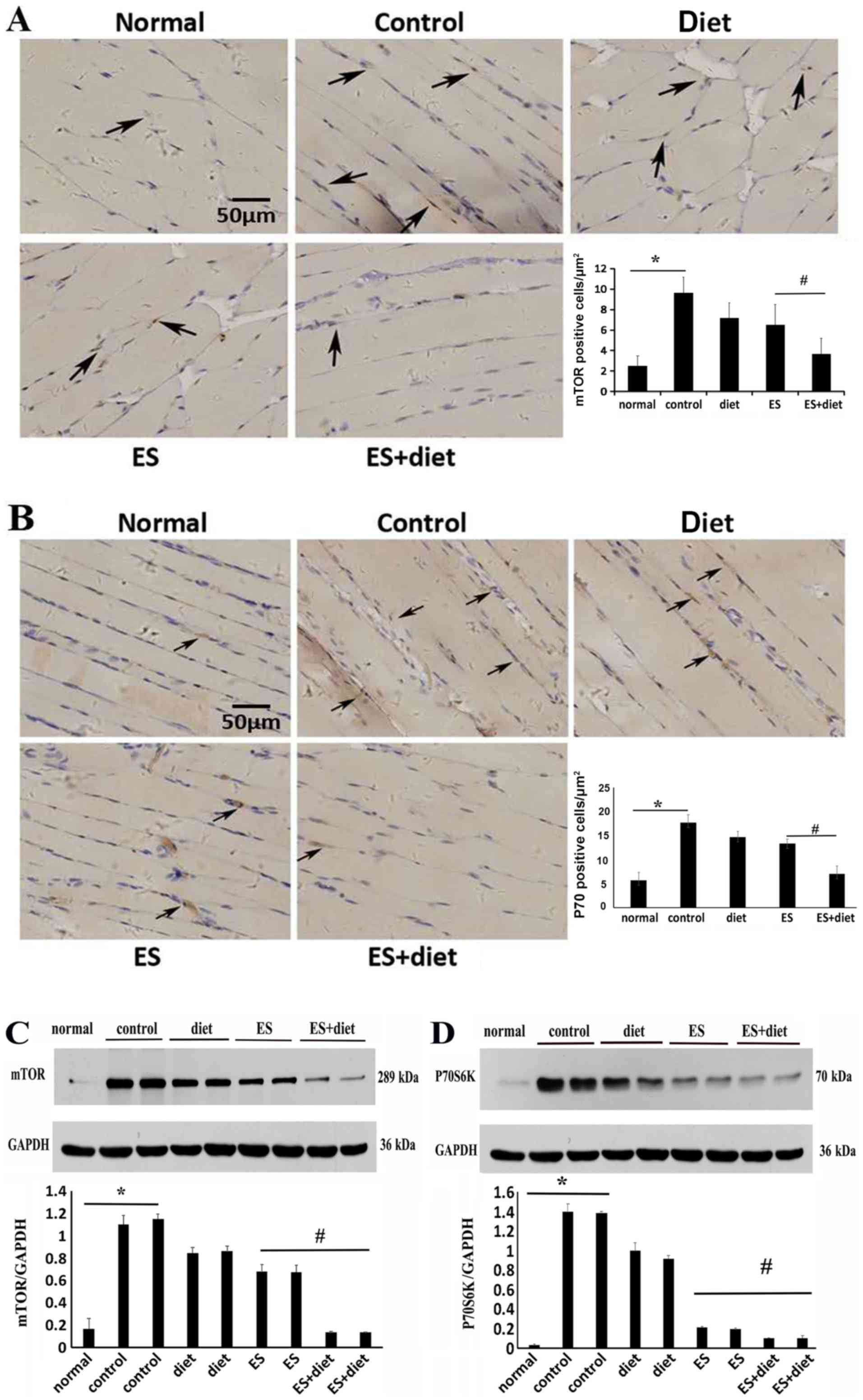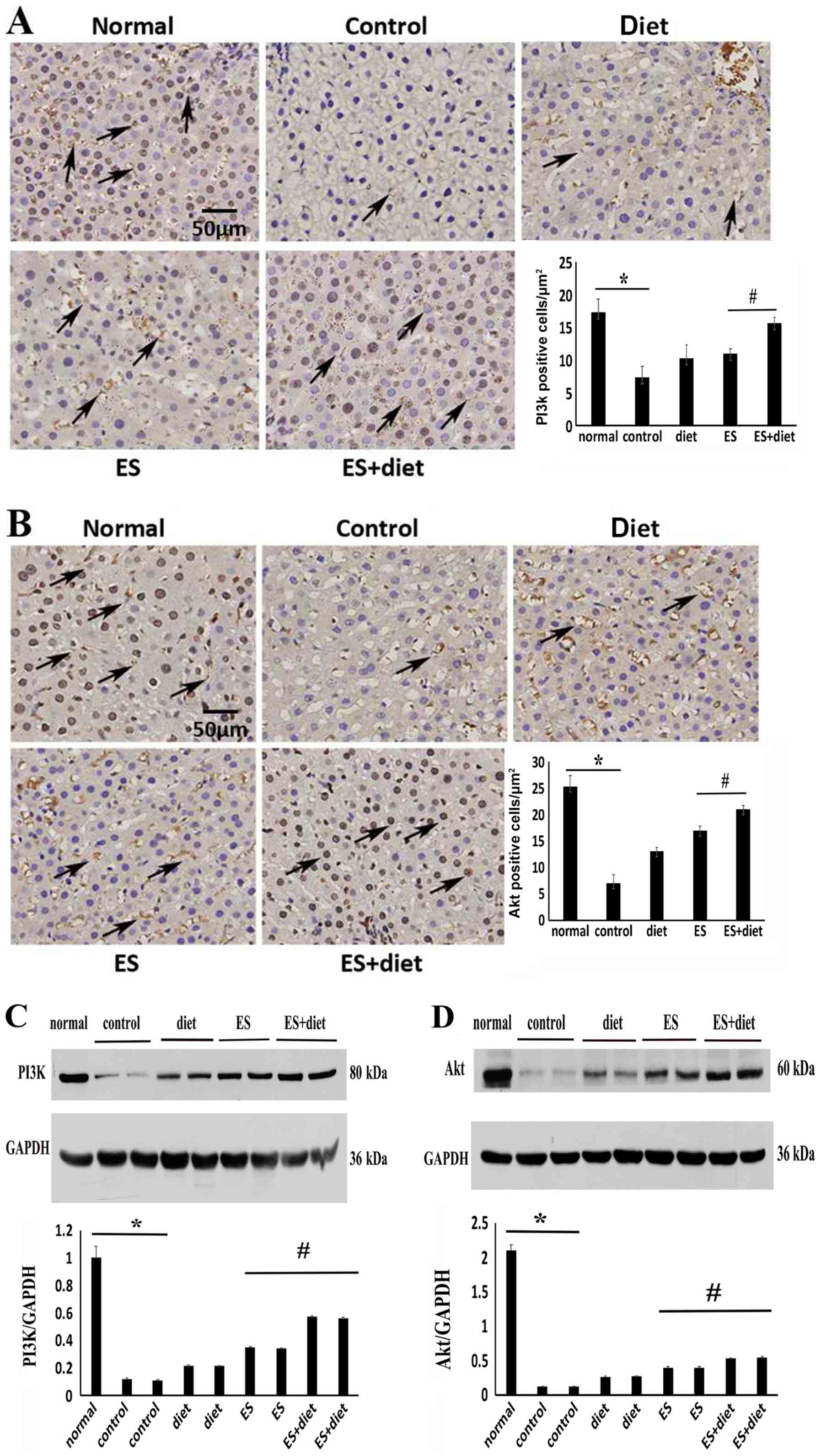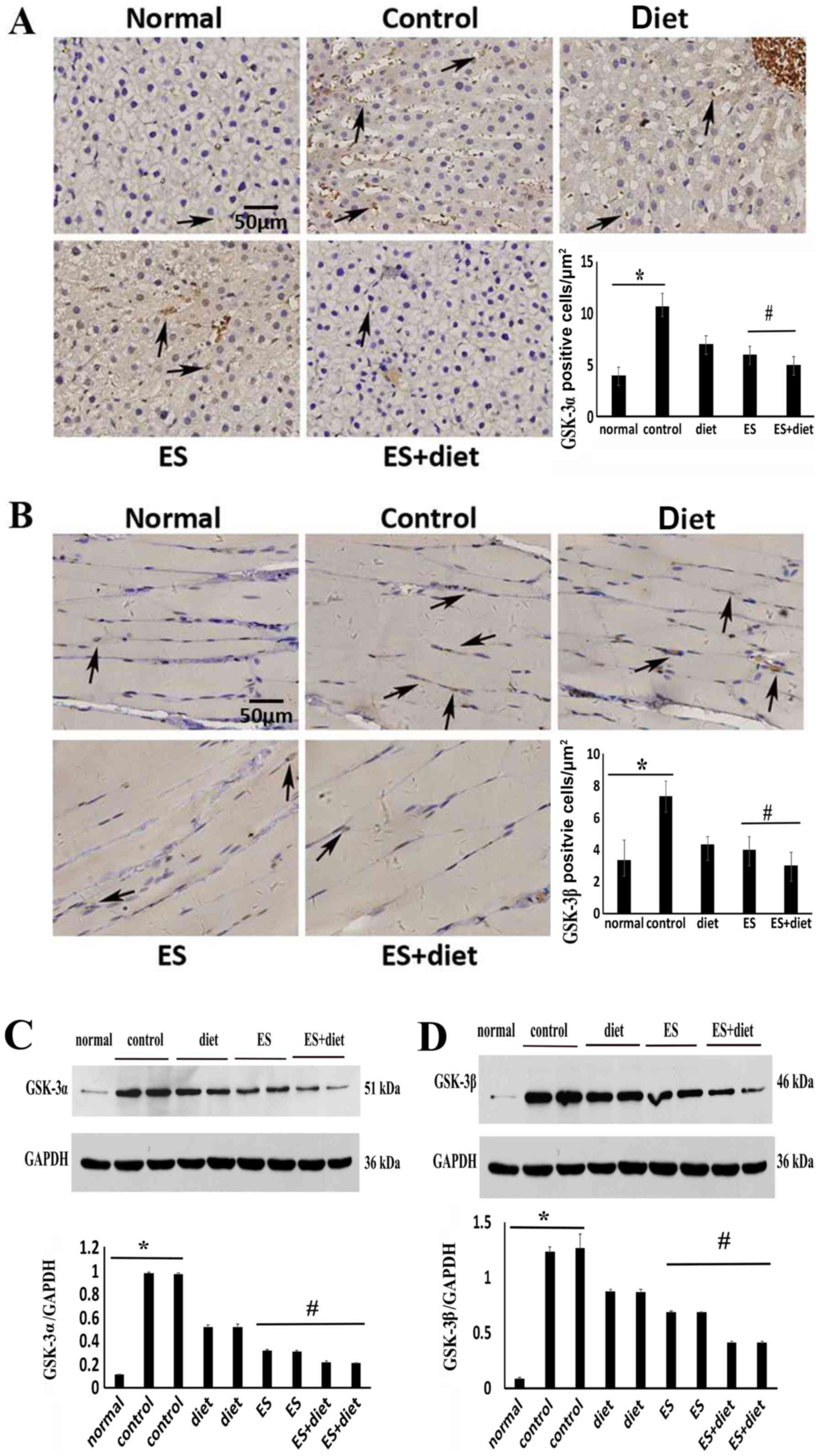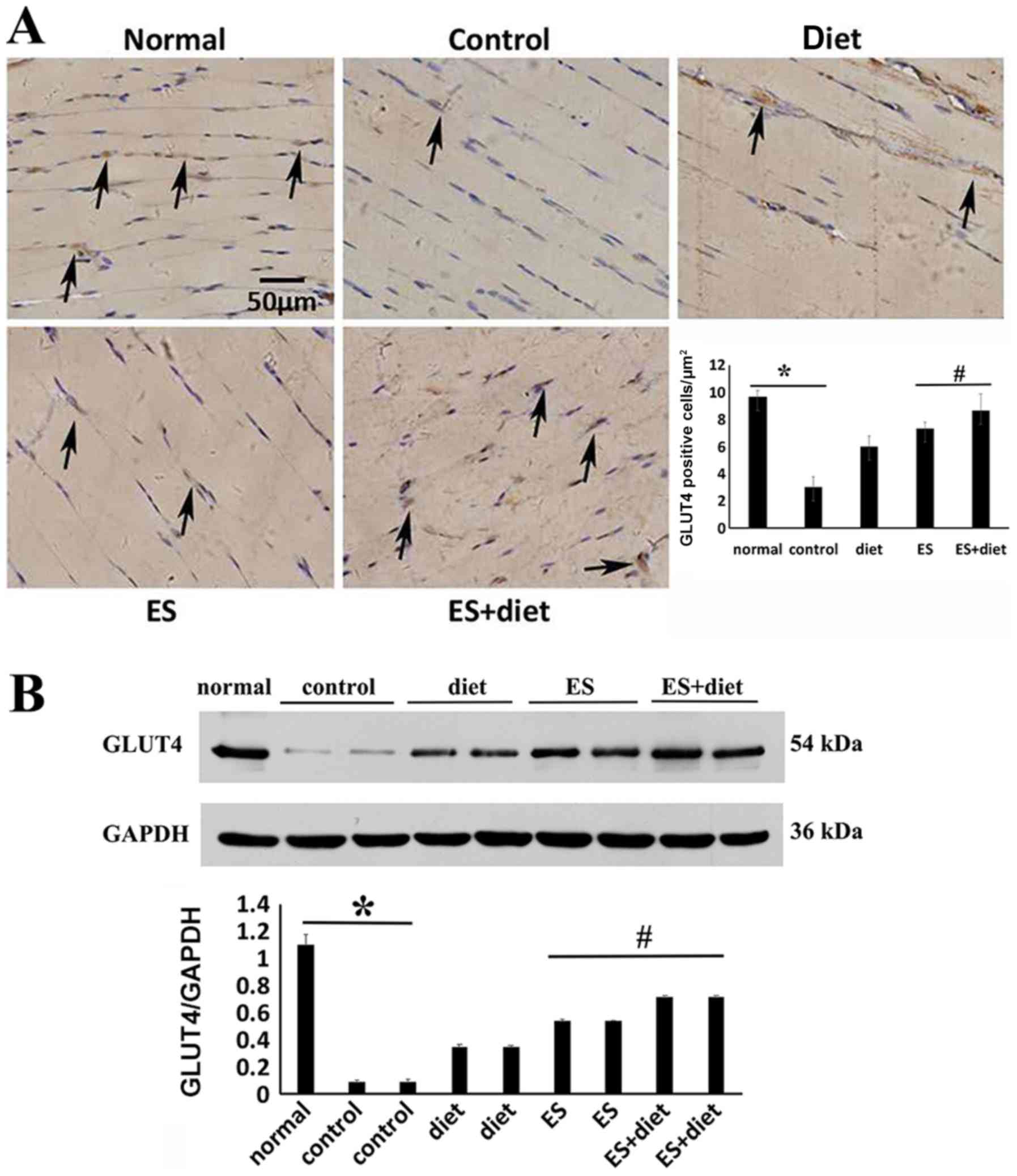|
1
|
Crescenzo R, Bianco F, Mazzoli A, Giacco
A, Liverini G and Iossa S: Mitochondrial efficiency and insulin
resistance. Front Physiol. 5:5122015. View Article : Google Scholar : PubMed/NCBI
|
|
2
|
Anusree SS, Nisha VM, Priyanka A and Raghu
KG: Insulin resistance by TNF-α is associated with mitochondrial
dysfunction in 3T3-L1 adipocytes and is ameliorated by punicic
acid, a PPARγ agonist. Mol Cell Endocrinol. 413:120–128. 2015.
View Article : Google Scholar : PubMed/NCBI
|
|
3
|
Kawaguchi T, Nakano D, Oriishi T and
Torimura T: Effects of isomaltulose on insulin resistance and
metabolites in patients with non-alcoholic fatty liver disease: A
metabolomic analysis. Mol Med Rep. 18:2033–2042. 2018.PubMed/NCBI
|
|
4
|
Lin RT, Tzeng CY, Lee YC, Chen YI, Hsu TH,
Lin JG and Chang SL: Acupoint-specific, frequency-dependent, and
improved insulin sensitivity hypoglycemic effect of
electroacupuncture applied to drug-combined therapy studied by a
randomized control clinical trial. Evid Based Complement Alternat
Med. 2014:3714752014. View Article : Google Scholar : PubMed/NCBI
|
|
5
|
Lee TI, Bai KJ, Chen YC, Lee TW, Chung CC,
Tsai WC, Tsao SY and Kao YH: Histone deacetylase inhibition of
cardiac autophagy in rats on a high-fat diet with low-dose
streptozotocin-induced type 2 diabetes mellitus. Mol Med Rep.
17:594–601. 2018.PubMed/NCBI
|
|
6
|
Lin JG, Chen WC, Hsieh C, Tsai CC, Cheng
YW, Cheng JT and Chang SL: Multiple sources of endogenous opioid
peptide involved in the hypoglycemic response to 15 Hz
electroacupuncture at the Zhongwan acupoint in rats. Neurosci Lett.
366:39–42. 2004. View Article : Google Scholar : PubMed/NCBI
|
|
7
|
Senna-Fernandes V, Franca D, Moreno SF,
Santos-Filho S, Rogers PA, Bernardo-Filho M and Guimarães MA: The
effect of ‘Zusanli’ (ST. 36) acupuncture on the bio-availability of
sodium pertechnetate in Wistar rats. Acupunct Electrother Res.
31:33–44. 2006. View Article : Google Scholar : PubMed/NCBI
|
|
8
|
Lee YC, Li TM, Tzeng CY, Cheng YW, Chen
YI, Ho WJ, Lin JG and Chang SL: Electroacupuncture-induced
cholinergic nerve activation enhances the hypoglycemic effect of
exogenous insulin in a rat model of streptozotocin-induced
diabetes. Exp Diabetes Res. 2011:9471382011. View Article : Google Scholar : PubMed/NCBI
|
|
9
|
Könner AC and Brüning JC: Selective
insulin and leptin resistance in metabolic disorders. Cell Metab.
16:144–152. 2012. View Article : Google Scholar : PubMed/NCBI
|
|
10
|
Cheng L, Song J, Li G, Liu Y, Wang Y, Meng
X, Sun G and Sun X: Effects of the Tangningtongluo formula as an
alternative strategy for diabetics via upregulation of insulin
receptor substrate-1. Mol Med Rep. 16:703–709. 2017. View Article : Google Scholar : PubMed/NCBI
|
|
11
|
Guo S, Copps KD, Dong X, Park S, Cheng Z,
Pocai A, Rossetti L, Sajan M, Farese RV and White MF: The Irs1
branch of the insulin signaling cascade plays a dominant role in
hepatic nutrient homeostasis. Mol Cell Biol. 29:5070–5083. 2009.
View Article : Google Scholar : PubMed/NCBI
|
|
12
|
Sarbassov DD, Guertin DA, Ali SM and
Sabatini DM: Phosphorylation and regulation of Akt/PKB by the
rictor-mTOR complex. Science. 307:1098–1101. 2005. View Article : Google Scholar : PubMed/NCBI
|
|
13
|
Tzatsos A and Kandror KV: Nutrients
suppress phosphatidylinositol 3-kinase/Akt signaling via
raptor-dependent mTOR-mediated insulin receptor substrate 1
phosphorylation. Mol Cell Biol. 26:63–76. 2006. View Article : Google Scholar : PubMed/NCBI
|
|
14
|
Panchal SK, Poudyal H, Iyer A, Nazer R,
Alam A, Diwan V, Kauter K, Sernia C, Campbell F, Ward L, et al:
High-carbohydrate high-fat diet-induced metabolic syndrome and
cardiovascular remodeling in rats. J Cardiovasc Pharmacol.
57:611–624. 2011. View Article : Google Scholar : PubMed/NCBI
|
|
15
|
Nozaki Y, Fujita K, Wada K, Yoneda M,
Shinohara Y, Imajo K, Ogawa Y, Kessoku T, Nakamuta M, Saito S, et
al: Deficiency of eNOS exacerbates early-stage NAFLD pathogenesis
by changing the fat distribution. BMC Gastroenterol. 15:1772015.
View Article : Google Scholar : PubMed/NCBI
|
|
16
|
Leng S, Zhang W, Zheng Y, Liberman Z,
Rhodes CJ, Eldar-Finkelman H and Sun XJ: Glycogen synthase kinase 3
beta mediates high glucose-induced ubiquitination and proteasome
degradation of insulin receptor substrate 1. J Endocrinol.
206:171–181. 2010. View Article : Google Scholar : PubMed/NCBI
|
|
17
|
Nikoulina SE, Ciaraldi TP, Mudaliar S,
Carter L, Johnson K and Henry RR: Inhibition of glycogen synthase
kinase 3 improves insulin action and glucose metabolism in human
skeletal muscle. Diabetes. 51:2190–2198. 2002. View Article : Google Scholar : PubMed/NCBI
|
|
18
|
Kahn BB, Rossetti L, Lodish HF and Charron
MJ: Decreased in vivo glucose uptake but normal expression of GLUT1
and GLUT4 in skeletal muscle of diabetic rats. J Clin Invest.
87:2197–2206. 1991. View Article : Google Scholar : PubMed/NCBI
|
|
19
|
Zhang L, Keung W, Samokhvalov V, Wang W
and Lopaschuk GD: Role of fatty acid uptake and fatty acid
beta-oxidation in mediating insulin resistance in heart and
skeletal muscle. Biochim Biophys Acta. 1801:1–22. 2010. View Article : Google Scholar : PubMed/NCBI
|
|
20
|
Zeyda M and Stulnig TM: Obesity,
inflammation, and insulin resistance-a mini-review. Gerontology.
55:379–386. 2009. View Article : Google Scholar : PubMed/NCBI
|
|
21
|
Sparks LM, Xie H, Koza RA, Mynatt R,
Hulver MW, Bray GA and Smith SR: A high-fat diet coordinately
downregulates genes required for mitochondrial oxidative
phosphorylation in skeletal muscle. Diabetes. 54:1926–1933. 2005.
View Article : Google Scholar : PubMed/NCBI
|
|
22
|
McGarry JD: Banting lecture 2001:
Dysregulation of fatty acid metabolism in the etiology of type 2
diabetes. Diabetes. 51:7–18. 2002. View Article : Google Scholar : PubMed/NCBI
|
|
23
|
Lund S, Holman GD, Schmitz O and Pedersen
O: Contraction stimulates translocation of glucose transporter
GLUT4 in skeletal muscle through a mechanism distinct from that of
insulin. Proc Natl Acad Sci USA. 92:5817–5821. 1995. View Article : Google Scholar : PubMed/NCBI
|
|
24
|
James DE, Strube M and Mueckler M:
Molecular cloning and characterization of an insulin-regulatable
glucose transporter. Nature. 338:83–87. 1989. View Article : Google Scholar : PubMed/NCBI
|
|
25
|
Zorzano A, Wilkinson W, Kotliar N, Thoidis
G, Wadzinkski BE, Ruoho AE and Pilch PF: Insulin-regulated glucose
uptake in rat adipocytes is mediated by two transporter isoforms
present in at least two vesicle populations. J Biol Chem.
264:12358–12363. 1989.PubMed/NCBI
|
|
26
|
DeFronzo RA, Jacot E, Jequier E, Maeder E,
Wahren J and Felber JP: The effect of insulin on the disposal of
intravenous glucose. Results from indirect calorimetry and hepatic
and femoral venous catheterization. Diabetes. 30:1000–1007. 1981.
View Article : Google Scholar : PubMed/NCBI
|
|
27
|
Ivy JL and Kuo CH: Regulation of GLUT4
protein and glycogen synthase during muscle glycogen synthesis
after exercise. Acta Physiol Scand. 162:295–304. 1998. View Article : Google Scholar : PubMed/NCBI
|
|
28
|
Grimes CA and Jope RS: The multifaceted
roles of glycogen synthase kinase 3beta in cellular signaling. Prog
Neurobiol. 65:391–426. 2001. View Article : Google Scholar : PubMed/NCBI
|
|
29
|
Laplante M and Sabatini DM: mTOR signaling
in growth control and disease. Cell. 149:274–293. 2012. View Article : Google Scholar : PubMed/NCBI
|
|
30
|
Kaidanovich-Beilin O and Eldar-Finkelman
H: Long-term treatment with novel glycogen synthase kinase-3
inhibitor improves glucose homeostasis in ob/ob mice: Molecular
characterization in liver and muscle. J Pharmacol Exp Ther.
316:17–24. 2006. View Article : Google Scholar : PubMed/NCBI
|
|
31
|
Pearce NJ, Arch JR, Clapham JC, Coghlan
MP, Corcoran SL, Lister CA, Llano A, Moore GB, Murphy GJ, Smith SA,
et al: Development of glucose intolerance in male transgenic mice
overexpressing human glycogen synthase kinase-3beta on a
muscle-specific promoter. Metabolism. 53:1322–1330. 2004.
View Article : Google Scholar : PubMed/NCBI
|
|
32
|
Sun XJ and Liu F: Phosphorylation of IRS
proteins Yin-Yang regulation of insulin signaling. Vitam Horm.
80:351–387. 2009. View Article : Google Scholar : PubMed/NCBI
|
|
33
|
Taniguchi CM, Emanuelli B and Kahn CR:
Critical nodes in signalling pathways: Insights into insulin
action. Nat Rev Mol Cell Biol. 7:85–96. 2006. View Article : Google Scholar : PubMed/NCBI
|
|
34
|
Højlund K and Beck-Nielsen H: Impaired
glycogen synthase activity and mitochondrial dysfunction in
skeletal muscle: Markers or mediators of insulin resistance in type
2 diabetes? Curr Diabetes Rev. 2:375–395. 2006. View Article : Google Scholar : PubMed/NCBI
|
|
35
|
Shulman GI, Rothman DL, Jue T, Stein P,
DeFronzo RA and Shulman RG: Quantitation of muscle glycogen
synthesis in normal subjects and subjects with
non-insulin-dependent diabetes by 13C nuclear magnetic resonance
spectroscopy. N Engl J Med. 322:223–228. 1990. View Article : Google Scholar : PubMed/NCBI
|
|
36
|
Chang SL, Lin KJ, Lin RT, Hung PH, Lin JG
and Cheng JT: Enhanced insulin sensitivity using electroacupuncture
on bilateral Zusanli acupoints (ST 36) in rats. Life Sci.
79:967–971. 2006. View Article : Google Scholar : PubMed/NCBI
|
|
37
|
Pai HC, Tzeng CY, Lee YC, Chang CH, Lin
JG, Cheng JT and Chang SL: Increase in plasma glucose lowering
action of rosiglitazone by electroacupuncture at bilateral Zusanli
acupoints (ST.36) in rats. J Acupunct Meridian Stud. 2:147–151.
2009. View Article : Google Scholar : PubMed/NCBI
|
|
38
|
Pan H, Huang H, Zhang L, Ma S, Yang H and
Wang H: ‘Adjusting internal organs and dredging channel’
electroacupuncture treatment prevents the development of diabetic
peripheral neuropathy by downregulating glucose-related protein 78
(GRP78) and caspase-12 in streptozotocin-diabetic rats. J Diabetes.
Mar 8–2019.(Epub ahead of print). View Article : Google Scholar :
|
|
39
|
MacAulay K and Woodgett JR: Targeting
glycogen synthase kinase-3 (GSK-3) in the treatment of Type 2
diabetes. Expert Opin Ther Targets. 12:1265–1274. 2008. View Article : Google Scholar : PubMed/NCBI
|















